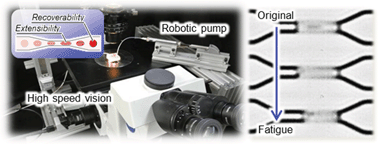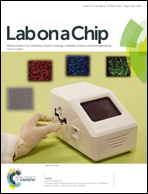Red blood cell fatigue evaluation based on the close-encountering point between extensibility and recoverability†
Abstract
Red blood cells (RBC) circulate the human body several hundred thousand times in their life span. Therefore, their deformability is really important, especially when they pass through a local capillary whose diameter can be as narrow as 3 μm. While there have been a number of works discussing the deformability in a simulated capillary such as a microchannel, as far as we examined in the literature, no work focusing on the change of shape after reciprocated mechanical stress has been reported so far. One of the reasons is that there have been no appropriate experimental systems to achieve such a test. This paper presents a new concept of RBC fatigue evaluation. The fatigue state is defined by the time of reciprocated mechanical stress when the extensibility and the recoverability characteristics meet each other. Our challenge is how to construct a system capable of achieving stable and accurate control of RBCs in a microchannel. For this purpose, we newly introduced two fundamental components. One is a robotic pump capable of manipulating a cell in the accuracy of ±0.24 μm in an equilibrium state with a maximum response time of 15 ms. The other is an online high speed camera capable of chasing the position of RBCs with a sampling rate of 1 kHz. By utilizing these components, we could achieve continuous observation of the length of a RBC over a 1000 times reciprocated mechanical stress. Through these experiments, we found that the repeat number that results in the fatigue state has a close correlation with extensibility.


 Please wait while we load your content...
Please wait while we load your content...